- Clinical Technology
- Adult Immunization
- Hepatology
- Pediatric Immunization
- Screening
- Psychiatry
- Allergy
- Women's Health
- Cardiology
- Pediatrics
- Dermatology
- Endocrinology
- Pain Management
- Gastroenterology
- Infectious Disease
- Obesity Medicine
- Rheumatology
- Nephrology
- Neurology
- Pulmonology
Skin Cancer:
ABSTRACT: Prevention of skin cancer requires photoprotection (eg, the use of a sunscreen with both UVB and UVA protection) and regular monitoring of the skin for suspicious lesions. Encourage patients to examine all areas of their skin, including the interdigital and genital regions, for unusual macules, papules, and nodules. Teach patients the "ABCDE" warning signs of melanoma (asymmetry, border irregularity, color variegation, diameter greater than 0.5 cm, evolving lesion). Office skin examinations are recommended for patients with risk factors for skin cancer and for those with obvious sun damage. Correct lighting, preferably daylight, and cross-illumination are crucial. Palpation may be helpful in detecting lesions such as actinic keratoses, which have a gritty, sandpaper-like surface.
UV radiation is an avoidable cause of skin cancer, the most common malignancy in the United States.1 Emphasize to patients that photoprotection strategies can reduce the incidence of melanoma and nonmelanoma skin cancers and can minimize photoaging. You can also teach patients to perform skin self-examinations and show them how to identify suspicious lesions that warrant medical evaluation.
In this article, we will review effective preventive measures. We will also discuss the evaluation and treatment of common skin cancers.
EFFECTS OF UV RADIATION
The major cause ofnonmelanomaskin cancer is UV radiation, which directly damages cells and alters immunological function.2 UVB is absorbed within the epidermis and upper dermis, where it can cause erythema (sunburn), edema, and hyperpigmentation.3,4 An initial phase of erythema is a prerequisite for the development of UVB-induced hyperpigmentation.3 Long-term UVB exposure results in photoaging, immunosuppression, and photocarcinogenesis.3 UVB exerts its carcinogenic effect in part by causing mutations in oncogenes and tumor suppressor genes.5 For instance, UVB-induced mutations in the p53 tumor suppressor gene inhibit protective cellular responses to UV damage.6
UVA, which has a longer wavelength than UVB, penetrates deeper into the dermis and causes oxidative stress that results in photoaging, immunosuppression, and possibly skin cancer.2 Photoaging results from structural damage to dermal collagen and elastin fibers; the clinical symptoms include dryness, irregular pigmentation, wrinkling, elastosis, telangiectasia, and purpura.
Cumulative sun exposure best correlates with the risk of squamous cell carcinoma (SCC), whereas episodic, and especially intense, sun exposure may better correlate with the risk of basal cell carcinoma (BCC) and melanoma.2,7
PREVENTION
Photoprotection and sun-safe strategies are listed in Table 1.
Types of sunscreen. Sunscreens may contain absorbents, reflectants, or a combination of both. Absorbent sunscreens (eg, avobenzone and ecamsule)constitute chemical filters that absorb a component of UV radiation. Reflectant sunscreens, such as titanium dioxide and zinc oxide,contain small particles that reflect or scatter UV radiation. While many sunscreens provide effective UVB protection, few adequate UVA sunscreens are available. The most effective UVA sunscreen ingredient that is available in the United States is ecamsule, which was approved by the FDA in July 2006.8,9
The ability of a sunscreen to prevent burning is indicated by its sun protection factor (SPF), which denotes the relative amount of time a person can tolerate UVB radiation exposure before erythema is induced. For example, a sunscreen with an SPF of 15 protects skin from erythema 15 times longer than would be possible without sunscreen. However, the SPF of a sunscreen relies on adequate and frequent reapplication.
An effective sunscreen regimen. This includes the daily, liberal application of a broad-spectrum sunscreen that contains avobenzone, ecamsule, or a micronized reflectant sunblock. The SPF should be at least 15. During outdoor activities, sunscreen should be reapplied every 2 hours and after swimming, toweling off, or excessive sweating.
Sunscreen and nonmelanoma skin cancer. The regular use of sunscreen prevents actinic keratosis, which can potentially develop into SCC.7,10,11 Use of a sunscreen with an SPF of 15 or higher during the first 18 years of life is hypothesized to decrease the lifetime incidence of BCC and SCC by 78%.12 However, UV damage accrues throughout life, and this hypothesis might diminish patients' motivation to use sunscreen regularly and properly later in life.Because SCC of the lip is particularly aggressive, lip balms with sunscreen are also recommended.13
Sunscreen and melanoma. The association between sunscreen use and melanoma protection is controversial.11,14 Although Hill and Ferrini15 concluded that there is insufficient evidence to recommend sunscreen use, particularly if it leads to increased sun exposure, most experts recommend sunscreen as part of a comprehensive photoprotection regimen.16 Advise patients that over-reliance on sunscreen protection can inadvertently lead to increased intensity and duration of sun exposure.
EARLY RECOGNITION
Self-examination. Training patients to perform self-examinations can increase the frequency of skin surveillance between visits, promote earlier detection of cancers, and result in a more focused and organized office skin examination.17 Self-examination also reinforces many photoprotection principles. Patients can be taught how to perform these examinations during office visits and by means of educational materials available on the Internet as well as in print (Box I).
Self-examination requires the use of a hand mirror or the help of an assistant to check every area of skin for unusual macules, papules, and nodules. Some health care providers and patients overlook the interdigital and genital regions; however, these are important locations for certain types of melanoma.12
Patients can use the "ABCDE" warning signs of melanoma to evaluate any unusual nevus (Table 2).18 As many as 67% of melanomas are detected by patients.19 Mortality associated with melanoma is reportedly lower in patients who perform skin self-examinations.20
Many patients wait until lesions are painful or bleeding before they seek care.21 Persons with darker skin may harbor the dangerous misconception that the additional melanin in their skin fully protects them from skin cancer. Educating patients about the epidemiology, prognosis, signs, and symptoms of skin cancers can allay fears and encourage earlier presentation.22
Office examination. Guidelines vary on the recommended frequency of office skin examinations (Box II). The US Preventive Services Task Force found insufficient evidence to recommend routine screening with a total-body skin examination for the early detection of cutaneous melanoma, BCC, and SCC.23 The organization with the most stringent guidelines, the American Cancer Society, recommends a cancer-related checkup, including a skin examination, during the periodic physical examination for all adults older than 20 years.24 The American Academy of Dermatology recommends at least annual dermatologist-conducted skin examinations, especially for patients at high risk for melanoma.25
A survey showed that the greatest obstacle to performing a skin examination in a primary care setting is lack of time.26 Clinicians were more likely to provide skin examinations for patients who requested them.26
Patients can be examined for signs of skin cancer during routine physical examinations, or they can be referred to dermatologists, free skin cancer screenings, and self-education materials.21 Patients who have risk factors for skin cancer and those who have obvious signs of sun damage need to be examined regularly and counseled about photoprotective strategies.21 Risk factors for melanoma include a history of blistering sunburns in childhood, atypical nevi, and melanoma in a first-degree family member.Encourage all patients to perform regular skin self-examinations.21
Melanomas are 6 times more likely to be detected when all skin is visible during an examination.12 The hands are an easy location to start with and may put your patient at greater ease. Correct lighting and cross-illumination are crucial. Daylight is ideal; however, a combination of incandescent light, which enhances red colors, and fluorescent light, which enhances blue and yellow colors, is acceptable.21 Cross-illumination highlights subtle changes in elevation and reduces glare.21
Palpation of cutaneous lesions may help diagnose skin cancers. Actinic keratosis has a gritty, sandpaper-like surface.21 The pearly quality of a BCC may be better appreciated on blanching.21 Debridement of crusts may be necessary to visualize underlying skin lesions.21
FEATURES OF COMMON SKIN CANCERS
Table 3 highlights key characteristics of common skin cancers.
Basal cell carcinoma. BCC is 4 times as common as SCC.21
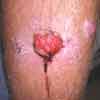
Figure 1
Nodular BCC-the most common type of BCC-is a pearly, indurated papule or nodule (Figure 1).27 Telangiectasia may become apparent as the lesion enlarges.
Pigmented BCC typically presents as a shiny, blue-black papule, nodule, or plaque (Figure 2).27 Although pigmented BCC may resemble melanoma, it often can be distinguished by its speckled and waxy appearance or rolled borders.21
Sclerosing BCC (also known as scarring or morpheaform BCC) is the most difficult to treat because it may extend beyond its clinically assessed borders.25 The atrophic, white plaque resembles a scar.27
Superficial BCC is a red, slightly pearly, occasionally scaly, relatively well-demarcated papule or plaque (Figure 3).27
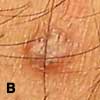
Figure 2 A
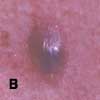
Figure 2B
Squamous cell carcinoma. SCC is usually a pink to red, scaly papule or plaque (Figure 4). The lesion may also develop as an indurated nodule within a chronic scar.21 Common sites for SCC include the head and neck, followed by the hands, forearms, upper trunk, and lower legs.25 SCCs have a low probability of metastasis. However, deeper lesions or lesions on the lip or ear are much more likely to metastasize.25
Actinic keratosis (also known as solar or senile keratosis) often precedes SCC; therefore, assessment of this lesion for induration and hyperkeratosis-signs that may herald a SCC-is important.25The incidence of actinic keratosis increases with age.28 The lesion is a rough, scaly papule or plaque that is sometimes easier to diagnose by touch than by sight (Figure 5).Actinic keratosis is usually diagnosed clinically, without histopathological confirmation.
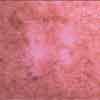
Figure 3
Melanoma. Although melanoma accounts for only 10% of dermatological malignancies, it is responsible for 75% of skin cancer mortality.25 Overall mortality rates for melanoma are higher in men than in women. It is the most common cancer among whites aged 25 to 29 years.21
Melanoma is characterized by aggressive local growth and metastasis.25 Most primary cutaneous malignant melanomas arise de novo from melanocytes and nevus cells. With the exception of nodular melanoma, melanomas have a horizontal growth phase followed by a vertical growth phase.27 Some physicians may find dermoscopy useful for evaluating skin neoplasms; however, they should perform an excisional biopsy of any lesion suggestive of melanoma.25,29
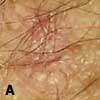
Figure 4A
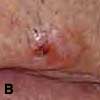
Figure 4B
Superficial spreading melanoma accounts for 70% of melanomas30; it may occur as a red, white, blue, brown, or black papule or nodule (Figure 6).27A superficial spreading melanoma may arise anywhere on the body but commonly appears on the backs of men and the lower legs of women.27
Nodular melanoma accounts for 15% of melanomas.30 It is often a blue-black nodule27; however, it may appear as a flesh-colored or vascular tumor.25Nodular melanomas tend to present at an advanced stage because of the lack of a horizontal growth phase.
Acral lentiginous melanoma accounts for 10% of all melanomas; it occurs on the glabrous skin of the palms, fingers, soles, toes, and nail beds.31 Pigment in the skin of the proximal or lateral nail folds (Hutchinson sign) strongly suggests acral lentiginous melanoma. In African, Asian, and Hispanic persons, the incidence of acral lentiginous melanoma is relatively higher than that of other types of melanoma. Acral lentiginous melanoma is often diagnosed at a later stage than other melanomas and, as a result, has a poor prognosis.31
Lentigo maligna melanoma presents as an unevenly colored brown-black macule on a background of sun-damaged skin of the face. It is characterized by an extended horizontal growth phase that often lasts years or decades before it invades the dermis.
TREATMENT
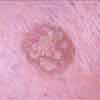
Figure 5
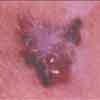
Figure 6
Nonmelanoma skin cancers. A suspected diagnosis of BCC should be confirmed by biopsy.The diagnosis ofSCC should be confirmed with histological examination before beginning treatment.
BCC.Curettage and electrodes- iccation can be used to treat nodular or superficial BCCs located below the neck, but not sclerosing or recurrent BCCs.25 BCCs above the neck are best treated by elliptical excision with a 3- to 5-mm margin of normal skin.
Mohs micrographic surgery is best reserved for sclerosing BCCs, recurrent tumors, and tumors in cosmetically or functionally sensitive areas.32
Radiation therapy may be used as the primary treatment of BCCs in patients older than 60 years who decline surgery or as an adjuvant to surgery for BCCs that show neural or lymphat- ic invasion.25 Radiation therapy may lead to radiation dermatitis or radiation-induced secondary carcinomas.
SCC. SCCs that occur on the trunk or extremities are typically treated with either curettage and electrodesiccation or excision, with a 4- to 5-mm margin of normal-appearing skin.25 SCCs above the neck that are smaller than 2 cm in diameter and have well-defined margins can be surgically excised with 4- to 5-mm margins.
Patients with SCCs greater than 2 cm in diameter and those with rapidly growing or recurrent SCCs are candidates for Mohs micrographic surgery.25
As in patients with BCC, radiation therapy may be used in patients older than 60 years who decline surgery. Radiation therapy may also be used as an adjunct to surgery in patients with high-risk SCC that exhibits perineural invasion or when cosmesis and function must be preserved.25
Actinic keratosis and superficial BCC. Imiquimod has FDA approval for the treatment of actinic keratosis and biopsy-confirmed, primary superficial BCC in immunocompetent adults.33 Imiquimod is an imidazoquinoline that stimulates cytokine secretion; up-regulates the production of interferon (IFN)-a, IFN-g, and interleukin (IL)-12; and inhibits the production of IL-4 and IL-5.34,35 The specific cytokines up-regulated by imiquimod are the same cytokines suppressed in BCC.36 Imiquimod is less likely to produce a complete response in larger tumors (greater than 2 cm in diameter).37 Imiquimod has also been used to treat nodular BCC, SCC in situ, melanoma in situ, and melanoma skin metastases.34,38
For actinic keratosis, imiquimod is applied to a confined area 2 times per week for 16 weeks. For superficial BCC, the standard imiquimod regimen is 5 applications per week without occlusion for 6 to 12 weeks.34 Compared with daily application, this 5-day-per-week dosing schedule reduces imiquimod's adverse effects, which include application site reactions, such as inflammation, pruritus, tenderness, and burning. The intensity of the application site reaction has been shown to correlate with the likelihood of histological clearance of the tumor.39 Imiquimod is less effective on the lower limbs relative to other sites.7,39 Follow-up of patients treated with imiquimod is required to ensure that their tumors have cleared.39
Melanoma. Biopsy of suspected melanoma should remove the entire lesion if possible because measurement of lesion thickness is essential for staging and assessment of lesion symmetry is often critical for accurate diagnosis. Refer patients who have a biopsy-confirmed melanoma of less than 1 mm in depth to a dermatologist for treatment.25 Although surgical resection can cure a local melanoma, lymph node evaluation may be indicated for melanomas with a depth greater than 1 mm. Thus, referral to a surgical oncologist or multidisciplinary skin oncology program is recommended for patients with thicker melanomas.30,40 When used as an adjuvant to surgery, IFN alfa-2b may prolong life in some cases.41,42
References:
REFERENCES:
1.
Gerbert B, Bronstone A, Wolff M, et al. Improving primary care residents' proficiency in the diagnosis of skin cancer.
J Gen Intern Med.
1998;13:91-97.
2.
Saladi RN, Persaud AN. The causes of skin cancer: a comprehensive review.
Drugs Today (Barc).
2005;41:37-53.
3.
Kullavanijaya P, Lim HW. Photoprotection.
J Am Acad Dermatol.
2005;52:937-958.
4.
Larsson P, Andersson E, Johansson U, et al. Ultra-violet A and B affect human melanocytes and kera-tinocytes differently. A study of oxidative alterations and apoptosis
.
Exp Dermatol.
2005;14:117-123.
5.
Drobetsky EA, Turcotte J, Chateauneuf A. A role for ultraviolet A in solar mutagenesis
.
Proc Natl Acad Sci U S A.
1995;92:2350-2354.
6.
Boukamp P. Non-melanoma skin cancer: what drives tumor development and progression?
Carcinogenesis.
2005;26:1657-1667.
7.
Marks R. An overview of skin cancers. Incidence and causation.
Cancer.
1995;75(2 suppl):607-612.
8.
Seite S, Colige A, Piquemal-Vivenot P, et al. A full-UV spectrum absorbing daily use cream protects human skin against biological changes occurring in photoaging.
Photodermatol Photoimmunol Photomed.
2000;16:147-155.
9.
Moyal D. Prevention of ultraviolet-induced skin pigmentation.
Photodermatol Photoimmunol Photo- med.
2004;20:243-247.
10.
Thompson SC, Jolley D, Marks R. Reduction of solar keratoses by regular sunscreen use.
N Engl J Med.
1993;329:1147-1151.
11.
Naylor MF, Boyd A, Smith DW, et al. High sun protection factor sunscreens in the suppression of actinic neoplasia.
Arch Dermatol
. 1995;131: 170-175.
12.
Rhodes A. Public education and cancer of the skin. What do people need to know about melanoma and nonmelanoma skin cancer?
Cancer.
1995;75 (2 suppl):613-636.
13.
Busick TL, Uchida T, Wagner RF Jr. Preventing ultraviolet light lip injury: beachgoer awareness about lip cancer risk factors and lip protection behavior.
Dermatol Surg.
2005;31:173-176.
14.
Drolet BA, Connor MJ. Sunscreens and the prevention of ultraviolet radiation-induced skin cancer.
J Dermatol Surg Oncol.
1992;18:571-576.
15.
Hill L, Ferrini RL. Skin cancer prevention and screening: summary of the American College of Preventive Medicine's practice policy statements.
CA Cancer J Clin.
1998;48:232-235.
16.
Morison WL. Photoprotection by clothing.
Der-
matol Ther.
2003;16:16-22.
17.
Robinson JK, Fisher SG, Turrisi RJ. Predictors of skin self-examination performance
.
Cancer.
2002; 95:135-146.
18.
Friedman RJ, Rigel DS, Kopf AW. Early detection of malignant melanoma: the role of physician examination and self-examination of the skin.
CA Cancer J Clin
. 1985;35:130-151.
19.
Richard MA, Grobb JJ, Avril MF, et al. Delays in diagnosis and melanoma prognosis (II): the role of doctors.
Int J Cancer
. 2000;89:280-285.
20.
Berwick M, Begg CB, Fine JA, et al. Screening for cutaneous melanoma by skin self-examination.
J Natl Cancer Inst
. 1996;88:17-23.
21.
Bruce AJ, Brodland DG. Overview of skin cancer detection and prevention for the primary care physician
.
Mayo Clin Proc.
2000;75:491-500.
22.
Goldstein AM, Tucker MA. Etiology, epidemiology, risk factors, and public health issues of melanoma.
Curr Opin Oncol
. 1993;5:358-363.
23.
Helfand M, Mahon SM, Eden KB, et al. Screening for skin cancer.
Am J Prev Med
. 2001;20(3 suppl): 47-58.
24.
Smith RA, Cokkinides V, Eyre H. American Cancer Society guidelines for the early detection of cancer, 2006.
CA Cancer J Clin.
2006;56:11-25.
25.
Jerant AF, Johnson JT, Sheridan CD, Caffrey TJ. Early detection and treatment of skin cancer
.
Am Fam Physician
. 2000;62:357-368.
26.
Geller AC, O'Riordan DL, Oliveria SA, et al. Overcoming obstacles to skin cancer examinations and prevention counseling for high-risk patients: results of a national survey of primary care physicians.
J Am Board Fam Pract.
2004;17: 416-423.
27.
Lookingbill DP, Marks JG, eds.
Principles of
Dermatology
. Philadelphia: WB Saunders; 2000.
28.
Chen GJ, Feldman SR, Williford PM, et al. Clinical diagnosis of actinic keratosis identifies an elder-ly population at high risk of developing skin cancer
.
Dermatol Surg.
2005;31:43-47.
29.
Argenziano G, Puig S, Zalaudek I, et al. Dermoscopy improves accuracy of primary care physicians to triage lesions suggestive of skin cancer.
J Clin Oncol
. 2006;24:1877-1882.
30.
Rager EL, Bridgeford EP, Ollila DW. Cutaneous melanoma: update on prevention, screening, diagnosis, and treatment.
Am Fam Physician.
2005;72: 269-276.
31.
Halder RM, Ara CJ. Skin cancer and photoaging in ethnic skin.
Dermatol Clin.
2003;21:725-732.
32.
Carucci JA, Leffell DF. Basal cell carcinoma. In: Freedberg IM, Eisen AZ, Wolff K, et al, eds.
Fitzpatrick's
Dermatology in General Medicine
. 6th ed. New York: McGraw-Hill; 2003:751.
33.
Keller CD. Imiquimod to treat basal cell and squamous cell carcinomas.
Am Fam Physician
. 2005;72:41.
34.
Chakrabarty A, Geisse JK. Medical therapies for non-melanoma skin cancer.
Clin Dermatol.
2004; 22:183-188.
35.
Sauder DN. Immunomodulatory and pharmacologic properties of imiquimod.
J Am Acad Dermatol
. 2000;43:S6-S11.
36.
Drehs MM, Cook-Bolden F, Tanzi EL, Weinberg JM. Successful treatment of multiple superficial basal cell carcinomas with topical imiquimod: case report and review of the literature.
Dermatol Surg.
2002;28:427-429.
37.
Scumack S, Gebauer K, Quirk C, et al. 5% imiquimod cream for the treatment of large superficial basal cell carcinoma.
Arch Dermatol.
2004;140: 1286-1287.
38.
Beutner KR, Geisse JK, Helman D, et al. Therapeutic response of basal cell carcinoma to the im-mune response modifier imiquimod 5% cream
.
J Am
Acad Dermatol.
1999;41:1002-1007.
39.
Marks R, Owens M, Walters S. Efficacy and safety of 5% imiquimod cream in treating patients with multiple superficial basal cell carcinomas.
Arch Dermatol.
2004;140:1284-1285.
40.
Berk DR, Johnson DL, Uzieblo A, et al. Sentinel lymph node biopsy for cutaneous melanoma: the Stanford experience, 1997-2004
.
Arch Dermatol
. 2005;141:1016-1022.
41.
Jemal A, Clegg LX, Ward E, et al. Annual report to the nation on the status of cancer, 1975-2001, with a special feature regarding survival.
Cancer
. 2004; 101:3-27.
42.
Agarwala S. Improving survival in patients with high-risk and metastatic melanoma: immunotherapy leads the way.
Am J Clin Dermatol
. 2003;4:333-346.
Atopic Dermatitis: The Pipeline and Clinical Approaches That Could Transform the Standard of Care
September 24th 2025Patient Care tapped the rich trove of research and expert perspectives from the Revolutionizing Atopic Dermatitis 2025 conference to create a snapshot of the AD care of the future.
